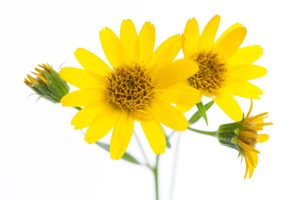
General information
Scientific name: Arnica montana
Other names: Wolf’s bane, Arnica Flowers, Arnica Root, Leopard’s Bane, Mountain Tobacco
Family: Asteraceae/Compositae
Habitat: Arnica is found in Europe from Scandinavia to southern Europe. It is also found in southern Russia and central Asia.
Medicinal Parts
Flowers, leaves, rhizomes, roots
The ethereal oil of the flowers are used, the flowers are usually dried, the leaves should be collected before flowering and dried, and the dried rhizome and roots.
Indications and Usage
Arnica’s therapeutic value includes anti-inflammatory, anti-rheumatic, cardio-vascular, contraceptive, fever reducer, hair growth stimulant, infection prophylaxis, non-narcotic antitussives, respiratory, venous insufficiencies, contusions, bruises, angina, asterioclerosis, bronchitis, blunt trauma, stomatitis, skin inflammation, phlebitis and menorrhagia.
Approved by Commission E:
- Fever and colds
- Inflammation of the skin
- Cough/bronchitis
- Inflammation of the mouth and pharynx
- Rheumatism
- Common cold
- Blunt injuries
- Tendency to infection
Folk Medicine: Traditional uses include injuries such as traumatic edema, contusions, hematoma, and also rheumatic muscle and joint problems. It is also used for inflammation of the mouth and throat, furunculosis, inflammation caused by insect bites and phlebitis. In Russia they also use it to treat uterine hemorrhaging. Furthermore, arnica is used for myocarditis, arteriosclerosis, angina pectoris, exhaustion, cardiac insufficiency, sprains, contusions and for hair loss due to psychological reasons. For some of these uses there is no research to prove its effectiveness.
Principal: Bruises, sprains.
Major: Unbroken chilblains, dislocations, inflammation caused by insect bites, oedema associated with fractures, rheumatic complaints in muscles and joints.
Minor: Furunculosis, phlebitis, cardiac insufficiency, angina pectoris and myocarditis.
Others: Oedema during the early postoperative period and phrophylaxis of pain in tonsillectomy.
Cautions
For use only on unbroken skin.
Side-effects and Contraindications
Known to cause skin irritation and inflammation.
There are other known hypersensitivity to other members of the Compositae family.
Prolonged use on damaged skin e.g. on injuries or crural ulcer, relatively frequently causes oedematous dermatitis with blistering; eczema may also arise with prolonged use; primary toxic skin reactions with blistering or even necrosis with dosage forms of higher concentrations, therefore pay close attention to the recommended dosage.
Arnica should not be taken internally except in suitable homeopathic/herbal dilutions. Oral administration of arnica is often accompanied by severe side effects and may even lead to death.
Dosage
Mode of Administration: Arnica is used in the form of the whole herb, cut herb or herb powder for infusions, extracts, and tinctures; gel, oil and poultice for external application.
Preparation: Arnica tincture (3x to 10x dilutions with water) is used to prepare a poultice. A tincture is prepared using 1 part Arnica flowers and 10 parts ethanol 70% v/v. Arnica oil is an extract of 1 part herb and 5 parts slightly warmed fatty oil. Ointments are made up of maximum 15% Arnica oil or with 10 to 25% tinctures in a neutral ointment base. Mouth washes/rinses are prepared as a tincture in 1Ox dilution. Tincture for cataplasm: tincture in 3x to 10x dilution.
Note: It is reported that the root of this plant loses a considerable portion of its odour and medicinal power quite easily, especially through boiling. However, freshly prepared powder dried rapidly and thoroughly in water-baths may be kept with almost unimpaired power for several years in well-corked phials.
Source:
Herbal Medicines Third edition pub. 2007 by Joanne Barnes, Linda A Anderson, J David Phillipson
PDR for Herbal Medicine pub. 2000 by Joerg Gruenwald, PhD etal
Samuel Hahnemann – materia Medica Pura
A Textbook of Materia Medica and Therapeutics of Rare Homeopathics Remedies pub. 1899 by Oscar Hansen MD
Dr Edward Shook’s Famous Course in Herbalogy published by Herbs of Mexico 2010
The information provided here are for educational purposes only, and is meant to help users better understand health concerns. This information should not be interpreted as specific medical advice. Users should consult with a qualified healthcare provider for specific questions regarding therapies, diagnosis and/or health conditions, prior to making therapeutic decisions.
DISCLAIMER: THIS WEBSITE DOES NOT PROVIDE MEDICAL ADVICE
The information, including but not limited to, text, graphics, images and other material contained on this website are for informational purposes only. The purpose of this website is to promote broad consumer understanding and knowledge of various health topics. It is not intended to be a substitute for professional medical advice, diagnosis or treatment. Always seek the advice of your physician or other qualified health care provider with any questions you may have regarding a medical condition or treatment and before undertaking a new health care regimen, and never disregard professional medical advice or delay in seeking it because of something you have read on this website.